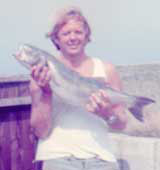how floating lures work
The weight and action of the lure will be marked on the pack, be it floating (F), slow sinking (SS) or sinking (S), but be prepared to search for it in the small print.
After being cast, floating lures sit on the surface and dive on the retrieve—the faster the retrieve, the deeper the lure will dive until its maximum depth is achieved. To enhance its wobbling movement, the speed of the retrieve can be varied or stopped, allowing the lure to rise before jerking it forward, giving it a diving, darting action.
To increase casting distance the body weights (red) are set in a tube inside the lure allowing them to  fall into the tail during the cast; rolling forward into the swimming position as soon as the lure dives on the retrieve. The rattle bead (green) is also set in a tube, allowing it to rattle from side to side as the lure wobbles through the water; the tail weights (blue) are fixed. The latest innovation is to have a magnet within the body of the lure that is strong enough to hold the moving weights in the forward position when the lure is being retrieved, but weak enough to allow the weights to drop into the tail when the lure is being cast.
fall into the tail during the cast; rolling forward into the swimming position as soon as the lure dives on the retrieve. The rattle bead (green) is also set in a tube, allowing it to rattle from side to side as the lure wobbles through the water; the tail weights (blue) are fixed. The latest innovation is to have a magnet within the body of the lure that is strong enough to hold the moving weights in the forward position when the lure is being retrieved, but weak enough to allow the weights to drop into the tail when the lure is being cast.
In Line Hooks 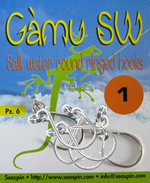
To reduce the problem of foul hooking fish around the head, the Seaspin Coixedda plugs, have Gamu Sw salt water inline single hooks in the belly and tail. There are other brands available— google inline lure hooks.
some plugs from my tackle bag.
Swimming on the surface is the 14·6cm Savage Gear Panic Prey V2, weighing in  at 16g. A good casting lure that floats with just its nose out of the water. As soon as the retrieve begins the tail jumps up and the lure swims on the surface. Check out 'walking the dog lure' on YouTube.
at 16g. A good casting lure that floats with just its nose out of the water. As soon as the retrieve begins the tail jumps up and the lure swims on the surface. Check out 'walking the dog lure' on YouTube.
This 10cm Coixedda 100 Shallow by Seaspin weighs in at 15g and dives to a maximum depth of 30cm.  It ships rigged with inline hooks and is available in a variety of holographic liveries. As expected it has a nose rattle and rolling body weights. It casts well and its action can be checked out on YouTube.
It ships rigged with inline hooks and is available in a variety of holographic liveries. As expected it has a nose rattle and rolling body weights. It casts well and its action can be checked out on YouTube.
Another modestly priced lure is the 11cm Storm Arishi Minnow, weighing in at 17g with a maximum swimming depth of 60cm. This is a classy looking lure that casts well, with a front rattle and rolling body weights. Check out 'Storm Arishi Minnow' on YouTube.
weighing in at 17g with a maximum swimming depth of 60cm. This is a classy looking lure that casts well, with a front rattle and rolling body weights. Check out 'Storm Arishi Minnow' on YouTube.
casting plugs and spinners.
Sitting between the floating plugs and metal spinners are the casting plugs which, as the name implies, are designed to achieve the maximum casting distance. 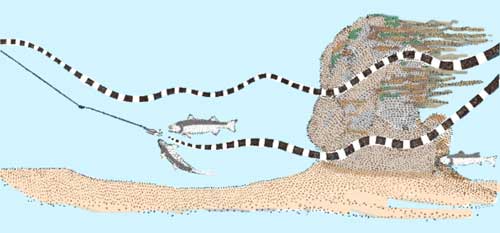 These are usually retrieved with a "sink and draw" action; meaning repeatedly lifting the rod to pull the lure forward, then retrieving line as the rod is lowered, giving the lure a forward rise and falling action. Check out sink and draw retrieve on YouTube.
These are usually retrieved with a "sink and draw" action; meaning repeatedly lifting the rod to pull the lure forward, then retrieving line as the rod is lowered, giving the lure a forward rise and falling action. Check out sink and draw retrieve on YouTube.
The topmost casting plug is a 7cm, 13g Fat Pencil Prey from Savage Gear in sand eel livery with a broad flat underside sloping up to the 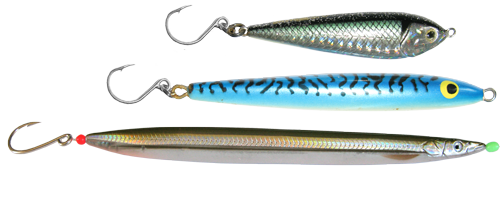 eye; check Savage Gear Fat Pencil Prey on YouTube. The 1990's 11cm, 20g, mackerel pencil beneath it and the latest Savage Gear Line Thro' Sand Eel both have a pointed nose, responding to a shorter sink and draw action.
eye; check Savage Gear Fat Pencil Prey on YouTube. The 1990's 11cm, 20g, mackerel pencil beneath it and the latest Savage Gear Line Thro' Sand Eel both have a pointed nose, responding to a shorter sink and draw action.
metal spinners

Metal spinners and casting plugs 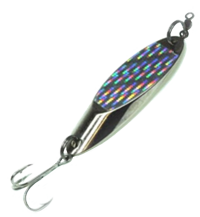
The most popular metal lure is the Dexter Wedge, which first hit the shops as a heavy boat lure, but being a good casting lure, as time went on got ever smaller and became available in a great variety of sizes and colours. Ships with a treble hook. Can be used with a straight retrieve or by sink and draw method.
Still very popular are the Toby spoons. Their shape gives them a good  swimming action on a straight medium to fast retrieve. Again this is an old school lure that still catches fish.
swimming action on a straight medium to fast retrieve. Again this is an old school lure that still catches fish.
Last but by no means least is the simple spinner that is designed to be 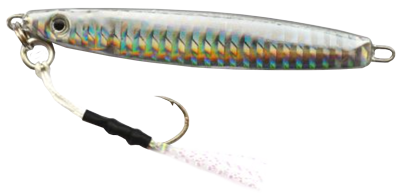 retrieved using the sink and draw method. The illustration is of a Tronix HTO Shore Jig rigged with hook assist. Years ago this rig used to be called a flying hook rig; available in almost any size and colour.
retrieved using the sink and draw method. The illustration is of a Tronix HTO Shore Jig rigged with hook assist. Years ago this rig used to be called a flying hook rig; available in almost any size and colour.
Hook assists can be purchased ready tied to fix on any lure.
spinning from the pier and quayside

The growing popularity of this method of angling from piers and quayside's is also concept angling; fishing for what is there rather than what might eventually come along; using very light rods, line and lures. However as the majority of fish landed will not be huge, it is even more important to adopt a catch and release ethos.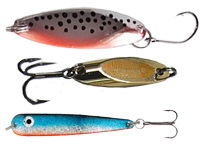
Street spinning tactics are about using ultra light metal spinners weighing from 3-8g as I have illustrated. Each of the three metal spinners weigh in at 3.5g and as with any other lure, these metal spinners are also available in 5g and 7.5g sizes
Spinning with these small lures will ensure you get the most excitement possible from the fish that you catch, before returning them alive to fight another day.
For this style of spinning very light tackle is a must, as is a small damp hand towel to hold the fish and a pair of forceps to remove the hook. Check out YouTube 'fishing Weymouth Pleasure Pier' and fishing 'Weymouth Stone Pier'.
For more on Street, LRF and HRF go to the links section on my contacts page to fully understand these modern styles of angling.


